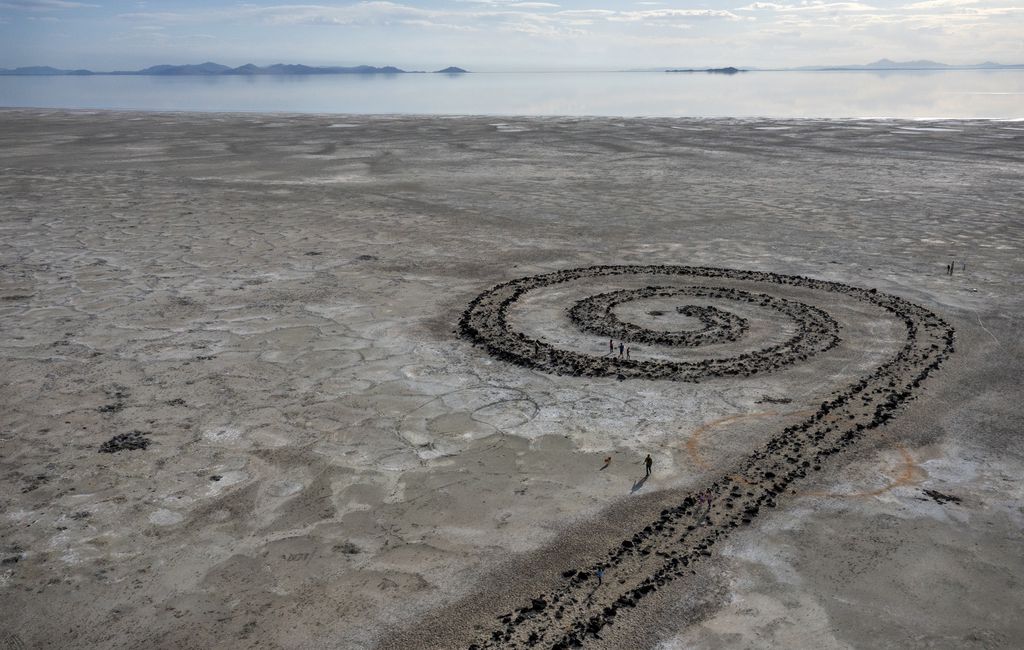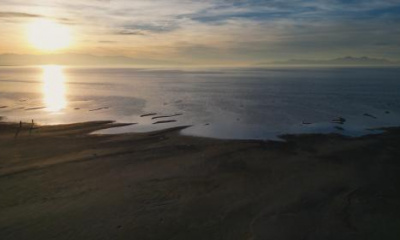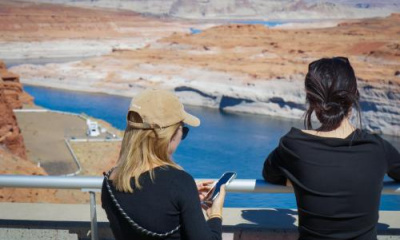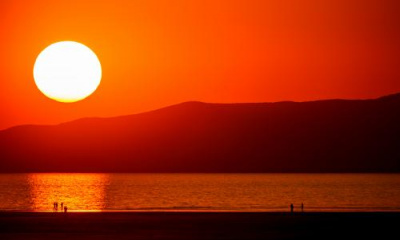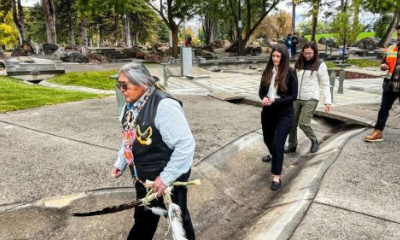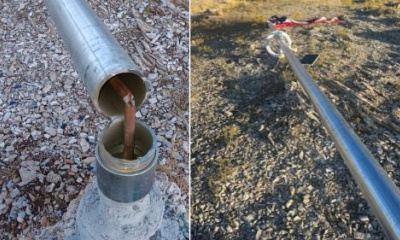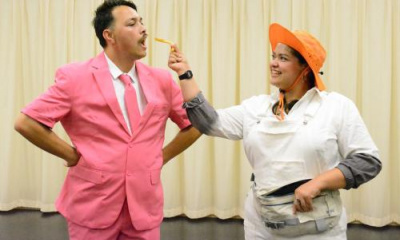Like any work of art, the value of Spiral Jetty — easily the most recognizable artwork in Utah — depends on how you look at it.
Jaimi Butler, the coordinator of Westminster College’s Great Salt Lake Institute, called the 1,500-foot rock formation artist Robert Smithson created in 1970 an “artistic water gauge” of the Great Salt Lake.
When Butler first visited the lake in the 1980s, the jetty was submerged under the waters of the Great Salt Lake, and one could throw rocks in the water from the side of the road.
“Now, if I stood in that same place, there’s not a chance I could ever throw a rock and hit the lake,” she said.
The jetty “is a barometer for the ways in which we are operating in a climate emergency,” said Lisa Le Feuvre, the head of the Holt/Smithson Foundation, which oversees the creative legacies of Smithson and his wife, Nancy Holt.
“It changes. It’s been surrounded by water. It’s been underwater,” Le Feuvre said. “Now, it’s very unlikely that the waters will ever reach Spiral Jetty because of the protracted droughts in the Great Basin Desert.”
Smithson never intended Spiral Jetty to be a barometer of anything, said Hikmet Sidney Loe, a former professor at Westminster College who wrote “The Spiral Jetty Encyclo” (University of Utah Press, 2017), a comprehensive book about Smithson and his most famous work.
In her book, Loe — who now teaches at the University of Nevada-Las Vegas — references a quote from Smithson, where he essentially says, “If the Spiral Jetty goes under the water, I’ll just build it up another 15 feet.”
“He wanted a very dynamic environment, so the salt crystals would form, dissipate, the colors would change and the water would rise and fall,” Loe said. “But he wasn’t [thinking], ‘In 50 years, here’s what people are going to think about my work.’”
(Leah Hogsten | The Salt Lake Tribune) People explore the Spiral Jetty, just south of the Rozel Point peninsula on the northeastern shore, March 25, 2022.
Art, out in the natural world
Robert Smithson and Nancy Holt — who created the art installation Sun Tunnels in the Utah west desert in Box Elder County — were among the leaders of what was called the “land art” movement, aimed at imposing large-scale artistic vision onto the natural world.
“Museums are tombs,” Smithson wrote in a 1967 essay, “Some Void Thoughts on Museums,” implying that artwork went to museums to die.
Smithson was seeking a canvas where the water was naturally colored red. He found it in the Great Salt Lake, and submitted a special use lease application to the Utah Department of Natural Resources. In the application, he stated the design intent of the jetty: “Its purpose is purely esthetic and it can be viewed from [an] airplane or from the road.”
Smithson hired contractor Bob Phillips and a crew to place 6,000 tons of black basalt rock in a line, 15 feet wide, which emerged from Rozel Point and then into the water in a counterclockwise formation.
The year 1970 was a significant one in the history of the environmental movement. The first Earth Day was staged in April of that year. In December, President Richard Nixon signed the bill creating the Environmental Protection Agency.
Smithson, Loe said, “wasn’t an out-and-out environmentalist. … It’s interesting because [Spiral Jetty] is a beacon for climate change, but that doesn’t mean Smithson anticipated that. He didn’t. None of us did.”
Loe pointed to another Smithson essay, published in 1971, where he wrote: “Art can become a resource that mediates between the ecologist and the industrialist. … Art can help to provide the needed dialectic between them.”
It was a conversation Smithson never got to finish. Smithson died on July 20, 1973, in a small-plane crash near Amarillo, Texas, where he was scouting a location for a new installation. He was 35 years old.
(Rachel Rydalch | The Salt Lake Tribune) The Spiral Jetty shows off as it is exposed from the receding waterline at the Great Salt Lake on Friday, March 25, 2022.
‘A state of constant transformation’
One of Smithson’s key concepts with Spiral Jetty was the idea of entropy — a scientific term that refers to the “gradual decline into disorder.”
According to the Dia Art Foundation, which owns the Spiral Jetty, “Smithson envisioned an artwork in a state of constant transformation whose form is never fixed and undergoes decay from the moment of its creation.”
Smithson, Le Feuvre said, was “always aware that any work he might make, any work anyone might make that sits within the landscape, will change over time.”
Le Feuvre added, “Smithson’s concern was really about asking questions about how we find our place on the surface of the planet. … I feel that when an artwork is released out into the world, when it leaves the artist’s hands and studio, it then takes on a life of its own.”
Art, Le Feuvre said, “can encourage us to raise questions. It demands we stop, we think and with that we take account for our interactions with the world.”
Rather than looking at Spiral Jetty as an object, as one might point to a painting, Le Feuvre suggested the jetty be seen as a field of information. “I often say that art is not there to provide solutions — design provides solutions,” she said.
For many years, starting in 1972, the lake’s water hid the jetty from view. The jetty reappeared briefly in 1980, then was covered by water until 1993; at its highest, in 1987, the water rose 16 feet above the rocks. The jetty was visible from 1993 to 1997, and was submerged again until 2002 — and has been above the water, and sometimes far away from the water, ever since.
The jetty’s re-emergence played a part in pushing back against an effort to drill for oil in the Great Salt Lake in 2008, Loe recalled. A Canadian company, Pearl Montana Exploration and Production, filed a proposal to drill in the lake’s north end, about 5 miles from Rozel Point.
Environmental groups — the Southern Utah Wilderness Alliance and Friends of the Great Salt Lake among them — campaigned against the drilling plan. Holt, Smithson’s widow, called upon her international network of artists to join the protest.
Loe wrote in her book that more than 3,500 people spoke out in support of the jetty and the surrounding ecosystem. Loe wrote an op-ed that ran in The Salt Lake Tribune in March 2008; Pearl Montana pulled its application that August.
Art may not change the world, Le Feuvre said, but it can change perceptions — and doing that can, sometimes, make it possible to change the world.
(Rachel Rydalch | The Salt Lake Tribune) People walk to the shoreline of the Great Salt Lake near the Spiral Jetty on Friday, March 25, 2022.
In and out of the water
Bonnie Baxter, the director of the Great Salt Lake Institute, said she first visited Rozel Point in 1998. Baxter went to see the jetty, but “I had been told not to bother, because it was underwater,” she said. “It was this mythical thing.”
Undaunted, she said she and some students went out in a canoe to collect water samples, and glided right over the submerged artwork. “The water was so thick with these microorganisms, we couldn’t even see the boulders that make up Spiral Jetty,” she said.
For the last 24 years, Baxter has studied the microorganisms that live in the water of the Great Salt Lake — such as the pigmented microbes that make the water turn pink, which is what originally attracted Smithson to the lake.
Baxter made her last visit to the jetty in April, and it was “completely shocking,” she said. “The water is almost a mile from Spiral Jetty.”
The receding water has been “frustrating” when it comes to collecting samples for her research. “You can have a sampling site where you take water every year, and you go back the next year, and that sampling site is gone,” she said.
Butler, the Great Salt Lake Institute coordinator, said less water can mean a higher salt content in the lake, which is “stressing the brine shrimp out” and leading to reproduction issues.
“If we put two feet of water in the lake, would they come back? We don’t know the answer to that question,” Butler said. “There’s all of these cascading effects of increasing salt content: Land bridges to breeding ground disturbance and exposure of these very important productive structures that form the base of the ecosystem.”
That base is formed by microbialites, the underwater reef-like rock mounds that line the lake and form the base of the lake’s ecosystem. If they are exposed to air and dry up, it would cut off the main food sources for brine shrimp and brine flies — which are the main food for migrating birds.
Another problem local experts have long worried about — the possibility that a dried lake bed would expose chemicals that could hasten snowmelt and be kicked up into toxic dust that would poison the air — was recently given national exposure by an article in The New York Times.
As a symbol of the lake’s problems, Butler said, “Spiral Jetty is very impactful for the Great Salt Lake in a very positive way.”
Artwork created in the environment should echo something about that environment, Baxter said, which is why she finds Spiral Jetty so fascinating. “Even though it’s out of the water and much more static now, it continues to evolve,” she said.
Both Baxter and Butler point to several solutions the public can implement to help the Great Salt Lake — starting with voting for lawmakers who will implement smart water laws. (Baxter said this year’s session of the Utah Legislature was “once in a lifetime” because of the number of bills and laws passed that related to water policy.)
“Everybody has to do everything,” Butler said. “Anything in your power, do it. Save water. Write your legislator. Tell your grandma about it.”
Teaching about the jetty
The Utah Museum of Fine Arts, one of Dia’s on-the-ground stewards of Spiral Jetty, also works to help educate the public about the artwork and the surrounding lake.
Whitney Tassie, UMFA’s curator of modern and contemporary art, said the museum’s plan of action these days is more about “prevention than preservation.” This includes encouraging such actions as a “leave no trace” site around the jetty and raising awareness about protecting the landscape itself.
“Like any good work of art, the jetty has always made us aware of our surroundings,” Tassie said. “Earthworks particularly help us understand our relationship with the environment, so climate change playing out through the lens of the jetty makes sense.”
However, Tassie wouldn’t equate the Jetty to a “poster child of climate change.”
The way the Wasatch Front is laid out, there is not a lot of direct access to the lake — with locations like Great Salt Lake State Park, Antelope Island State Park and the jetty among the most notable exceptions. Spiral Jetty, Tassie said, is “one of the places where our community does interface with the lake,” and it’s important that the jetty is able to bring people to the lake.
Annie Burbidge Ream, UMFA’s assistant director of learning and engagement, said that “in the early days, we wanted people to get out to the site.” The museum used to have programs that took people out to the site, and instructed them to make sculptures from found materials.
More recently, Ream said, “our focus and attention has moved to also bringing awareness to conservation of the site.” Some of that effort involves giving K-12 teachers different lesson plans to incorporate in their classrooms, giving virtual tours and running programs to teach about what artists were thinking about when creating their artworks.
“Art is such an important factor for a solution to what’s happening,” Ream said, “because it requires people to think really creatively and critically about the position that we’re in right now in our world.”
No matter how the Great Salt Lake rises or falls, the basalt rocks of Spiral Jetty likely will stay where they are. Even that is unpredictable, though, as Smithson himself acknowledged in a 1966 essay: “Nature does not proceed in a straight line, it is rather a sprawling development.”

